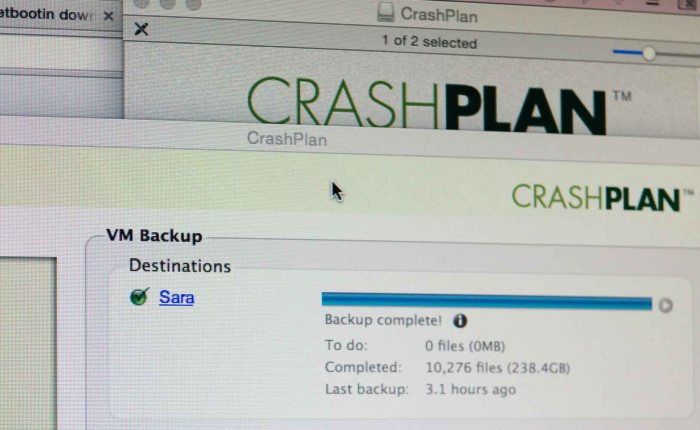So while I was updating my Mac Pro VM host, I decided to test the upgrades for my backup environment. It should have been straightforward but as usual I must have done a little too much clean up from the last time.
For my backups I’m using Code42’s Crashplan Enterprise platform. It’s surprisingly affordable and robust which is why I recommend it to my clients. Upgrades, however, are a bit of a tricky mess. Code42 recommends you test the upgrades and for good reason. You don’t want to lose your backups. And sometimes these upgrades don’t go as smoothly as expected.
I have 2 test VMs setup as Master and Storage servers for CP Enterprise mirroring what I have in production (except for the backup data). I had expected that since the last upgrade they would be at the current production version so I could just restore the prod databases to them an get on. But it turns out I had decided last time to wipe clean these VMs and so my CP Enterprise directories for both VMs stood bare with nary an installation to be found.
This meant that before even testing an upgrade, I had to get them back up to the version in prod. Why didn’t I just copy the production VMs across? They’re simply too big. Why didn’t I take a snapshot from the last time? Well, because I’m a noob. Anyway, I still had the DB dumps from the previous upgrade and the installer and after figuring out I needed to turn the clock back a year for the upgrade to take (Code42 won’t let you upgrade if your license has expired), it was all good. I was back to production parity. This time I did take snapshots after patching Windows and restoring the latest prod database.
The upgrade process is fairly finicky. While testing the upgrade to 4.2.x I found that it would fail to complete if it couldn’t find my original prod storepoints. This took a while to figure out as I restored my snapshot a couple of times thinking that I had screwed up somewhere. Luckily, I could rename my test storepoints and the upgrade finally completed. It also complained about an expired token when I tried to upgrade the storage server but it turns out I just needed a fresh login.
After all, that it seemed to settle down and work fine which means I can start upgrading my production instances in the next scheduled maintenance.
Some notes for me: 4 things I need to test an upgrade.
- Current database dump from production.
- The CrashPlanPROServer_y.y.y.y_from_x.x.x.x_arch.upgrade file from the current version to the next.
- The CrashPlanPROServer-x64_y.y.y.y_Win.msi base installer. (Handy if you need to start again from scratch.) These will go away from the Code42 website so best grab them when you’re testing.
- Any CrashPlan app versions needed for the new server version.







